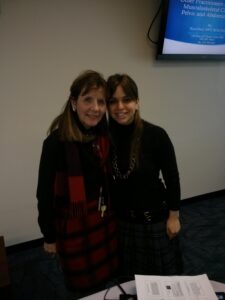
I’m happy to introduce today’s guest blogger, Dean Marie Dolla of Plaza College. I have had the wonderful opportunity to work with Marie and help her along her healing journey. Marie is a brave and outspoken champion on behalf of women’s health. Previously, she has openly shared her pelvic floor struggles with friends, colleagues, and students in order to educate others about this condition. As someone who was misdiagnosed and needlessly suffered for years before receiving an accurate diagnosis and treatment plan, Marie is committed to helping others receive care in a more timely and dignified manner.
Marie arrived to our session one week and said, “Riva, I am reading an amazing book, “Living Beyond Your Pain,” and it has helped me so much. You should tell other patients about it,” I responded, “Thank you, this sounds like an incredible resource. How would you like to share the wealth and be my guest blogger?” Marie, in her typical fashion, jumped on the opportunity to help others and agreed to do so. In this blog, Marie shares her story and discusses why she found the book so beneficial:
“I am sure you know the difference between acute and chronic pain, but if you have forgotten let me review this by example. Acute pain is short term as in when one breaks their wrist or ankle. Ouch, but it heals and generally it ends there. Chronic pain is constant or intermittent caused by car accidents and falls resulting in musculoskeletal misalignments, sexual abuse or difficult births which can affect the pelvic floor muscles. In my case, my pelvic pain was related to caring for an aging mother, handling a stressful job, going through menopause, and not self-caring.
So for me, super tight muscles in my pelvic floor is my pain that requires a multidisciplinary approach. It took four years before I received a correct diagnosis, I wanted to get rid of the pain. What I have learned to do is manage it—and without medications that have been touted by mainstream doctors.
During my journey, I got better…then a little worse…and then better again. If you try to avoid the pain, you will only suffer more pain. So accept it? Yes. By not doing that, my world became very narrow. I denied myself experiences I once cherished. So I was introduced to ACT—Accept, Choose and take action. Is this easy? No way. I’m still learning, but my life is opening up again. Thanks to my terrific medical team-my pelvic floor physician, Dr. Andrew Goldstein, my physical therapist, Dr. Riva Preil, and my CBT (cognitive behavioral therapist), Dr. Jana Scrivani.
In this self-help book, there are so many great hands on exercises. One of the hardest concepts for me to grasp has been to separate my thoughts from how I view my total self. On my first draft of this exercise, I completed statements about myself from the viewpoint of my pain. This is so wrong. I moved from “I am a person who experiences chronic pain from time to time” to “I am a person who enjoys teaching others new things. “ This technique is called cognitive diffusion. I need to practice this and to separate my thinking from my viewpoints about who I am—this whole person who has pain but who also has an amazing pair of red shoes. I am not my pain.
I am learning to take notice of my thoughts and let them come and go. This will help me separate my thoughts about pain and move me away from viewing myself through the pain lense.”
Marie, thank you so much for sharing your experience and for recommending “Living Beyond Your Pain.” We both hope that many readers will benefit from it!


